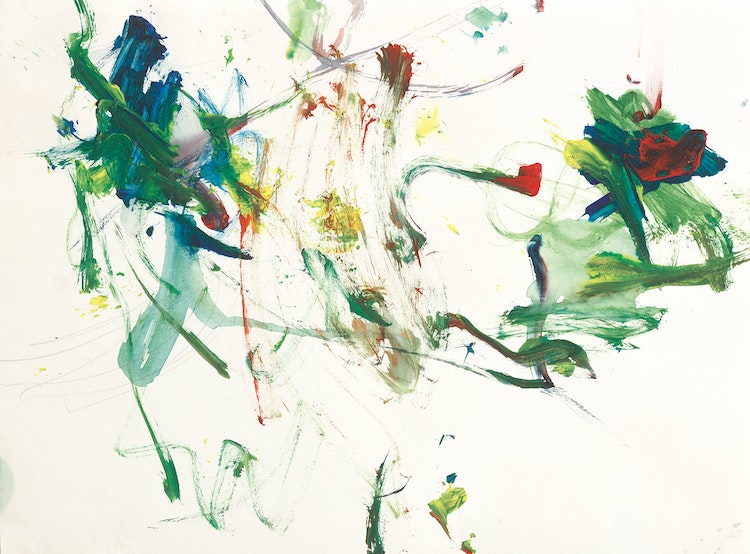Joan Mitchell was a prominent American artist closely associated with the Abstract Expressionist movement, the New York School, and international abstract painting of a gestural sort. She spent most of her professional life in France, first in Paris in the 1950s, and from 1967 in Vétheuil, Claude Monet’s home from 1878-1881. While in France she exhibited at the most acclaimed international venues for contemporary art, including 5th Bienal do Museo de Arte Moderna, São Paulo, Brazil (1959), Documenta II in Kassel, Germany (1959), and the 29th Venice Biennale (1958).

Typical of Mitchell’s art in general, Untitled is both delicate and powerful. She frequently worked on paper, expressing gestures that seem larger in scale than they actually are, in part because the forms animate a fundamentally open space. Areas in the upper left and right of this surface are particularly intense thanks to the accumulation of dark green, red, and blue pigment. If these zones might seem to implode from their own weight, for balance, Mitchell simultaneously thins some of her colours and streaks them across the surface. The light blue and delicate green skeins of pooled colour under the two denser forms to the left and right respectively seem to soak into the surface. Yet Mitchell’s brushstroke is always evident, moving the colour around no matter how ephemeral it becomes. This effect is especially evident in the centre of the work and holds the more heavily worked dancing forms apart.
The comparison of one artist with others in their immediate context or from a longer history is a hallmark of writing about art in museums, auction catalogues, and Art History. Mitchell is often discussed with reference to other women members of the AbEx circle‒Helen Frankenthaler or Lee Krasner, for example‒and especially with respect to her long-time life partner, the Canadian abstract painter Jean Paul Riopelle. Such comparisons can be enlightening, as many witnessed in the 2017-18 exhibition “Mitchell/Riopelle: Nothing in Moderation”, which systematically and extensively placed works by both abstractionists into visual conversation. Nonetheless, comparison invites the establishment of a hierarchy or of a false dichotomy, whether covertly or overtly displayed. It’s worth asking whether we should, in the face of Mitchell’s Untitled, default to comparisons at all.
Is the alternative to perceive this painting on its own terms? Do we see it as highly dynamic, an intimation of a life force and testimony to abstract painting’s abilities, or is it perhaps received as agitated, an embodiment of a delicate rage? The painting does not tell us what to see, think, or feel. It is a testament to what the eminent art historian Linda Nochlin (1931‒2017) ‒Mitchell’s contemporary and friend‒ memorably called the painter’s “poignant visual searching.”
We extend our thanks to Mark A. Cheetham, a freelance writer and curator and a professor of art history at the University of Toronto for contributing the preceding essay. He is author of Abstract Art Against Autonomy: Infection, Resistance, and Cure since the ‘60s (Cambridge University Press).

